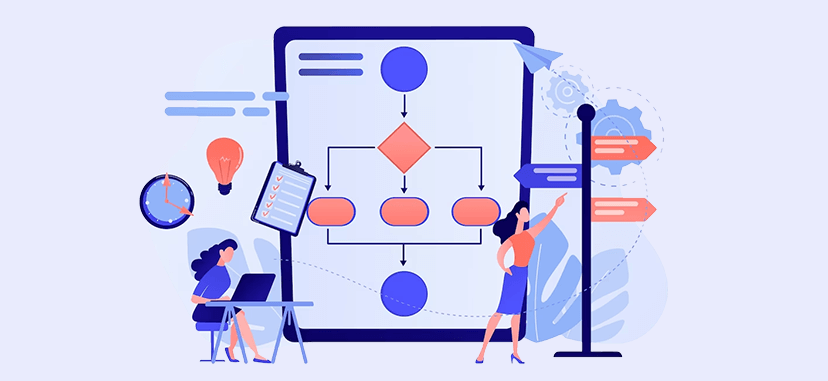
Click the button to start reading
How to Master Workflow Process Mapping: Unleash Your Workflow Superpowers!
Imagine you’re a world-renowned chef, preparing a complex gourmet dish in a bustling kitchen. You’ve got all the ingredients, tools, and skills, but you’re missing one crucial element: a detailed recipe. Without it, you and your team may end up cooking up chaos instead of culinary perfection.
That’s the kind of disarray you can expect when managing your business processes without workflow process mapping.
In today’s high-stakes business world, understanding and optimizing your organization’s processes is crucial to staying ahead of the competition. As virtual project management becomes more prevalent, the challenges of managing and streamlining workflows only intensify. But don’t worry, you’ve stumbled upon the ultimate guide to mastering workflow process mapping, which will help you whip your organization’s workflows into tip-top shape.
By the end of this article, you’ll have a firm grasp of the fundamentals of workflow process mapping and the skills to create clear, efficient, and effective workflow maps. You’ll discover different mapping techniques, learn how to choose the right one for your needs and get essential tips to make the process feel like a walk in the park.
So, are you ready to don your metaphorical chef’s hat and take control of your organization’s workflow kitchen? Let’s dive into the world of workflow process mapping and cook up some extraordinary business success.

Workflow Process Mapping 101: Get in the Know
What’s the Deal with Workflow Process Mapping?
Think of workflow process mapping as your organization’s secret decoder ring. It’s the key to unlocking a clear understanding of your business processes and workflows, helping you visualize each step, task, and participant involved. By creating a visual representation of how work moves through your organization, you can identify bottlenecks, redundancies, and inefficiencies that are lurking in the shadows.
For instance, let’s say your organization has a habit of lengthy email chains that often leave team members confused and tasks slipping through the cracks. Workflow process mapping can help you pinpoint these communication breakdowns and implement more efficient ways of collaborating.
Connecting the Dots between Workflow Process Mapping and Business Process Management (BPM)
Now you might be wondering how workflow process mapping relates to business process management (BPM). Well, they’re like two peas in a pod. BPM is the broader discipline of managing and optimizing your organization’s processes, and workflow process mapping is the critical tool that helps you achieve that goal.
BPM is like the conductor of an orchestra, ensuring all parts of your organization play in harmony, while workflow process mapping is the sheet music that guides each musician. Together, they empower your organization to perform at its best.
Pick Your Workflow Process Map: A Handy Guide
Navigating the Workflow Process Map Jungle: Flowcharts, Swimlane Diagrams, and More
Workflow process mapping is not a one-size-fits-all solution. Depending on your organization’s unique needs and goals, different types of maps can be more effective. Here’s a quick rundown of some popular workflow process maps:
- Flowcharts: These simple and versatile diagrams are perfect for illustrating the basic flow of work through a process. They use boxes to represent tasks, diamonds for decision points, and arrows to show the flow’s direction.
- Swimlane Diagrams: If you need to clarify roles and responsibilities, swimlane diagrams are your go-to choice. They divide a flowchart into “lanes” that represent different teams or individuals, making it easy to see who’s responsible for each task.
- Value Stream Maps: For those seeking to optimize end-to-end processes, value stream maps help visualize the flow of materials and information, as well as the time spent on each step.
How to Choose the Perfect Workflow Process Map for Your Unique Needs
Selecting the ideal workflow process map is like choosing the right tool for a job. Keep these factors in mind to make the best choice:
- Complexity: If you’re mapping a simple process, a basic flowchart may suffice. For more intricate workflows, consider using swimlane diagrams or value stream maps.
- Purpose: Identify your primary goal for mapping. Is it to clarify roles, optimize resource usage, or improve communication? Choose a map that best serves your purpose.
- Familiarity: Consider your team’s familiarity with different types of maps. If they’re already comfortable with a particular format, it might be wise to stick with it.

Roll up Your Sleeves: Your Step-by-Step Guide to Creating Workflow Process Maps
Sniffing Out Inefficiencies: Which Processes to Map
Before diving into the actual mapping, it’s crucial to identify the processes that need your attention. Start by listing out every process within your organization, no matter how big or small. This helps create a comprehensive view of your operations.
Then, ask yourself and your team which processes are causing headaches, delays, or other issues. These are prime candidates for mapping and optimization.
Finally, determine which processes are most critical to your organization’s success and prioritize them for mapping. Remember, focus on mapping the processes that truly matter, as they’ll have the most significant impact on your organization’s performance.
Matchmaker, Matchmaker: Pairing the Right Workflow Process Map with Your Business
Once you’ve identified the processes that need attention, it’s time to find the perfect workflow process map for your specific situation.
Here’s a quick recap to help you make the best choice: consider the complexity of the process, identify the purpose of the mapping exercise, and take into account your team’s familiarity with different types of maps. By following these guidelines, you’ll harness the power of your chosen workflow process map to optimize workflows and supercharge your organization’s efficiency.
Mastering the Workflow Process Mapping Essentials
Creating a successful workflow process map isn’t rocket science, but there are a few secret ingredients that can make all the difference. Keep these tips and tricks in mind as you embark on your workflow process mapping journey:
The Secret Ingredients for a Successful Workflow Process Map
- Clarity: Keep your maps simple, concise, and easy to understand. Use clear and consistent symbols, shapes, and colors.
- Accuracy: Ensure that your maps accurately reflect the current state of your processes, including all tasks, decision points, and handoffs.
- Inclusivity: Involve relevant stakeholders and team members in the mapping process to get a well-rounded perspective.
Tips and Tricks to Make Workflow Process Mapping a Breeze
- Start small: Begin with a simple process and gradually work your way up to more complex ones.
- Iterate: Don’t expect to create the perfect map on your first try. Instead, be prepared to iterate and refine your maps as you gather feedback and insights.
- Standardize: Establish a standardized approach to workflow process mapping to ensure consistency across your organization.
- Stay flexible: Be open to adapting your maps as your processes and organization evolve.

Dive Deeper: Advanced Workflow Process Mapping Tips and Tricks
Ready to take your workflow process mapping skills to the next level? You’ve got the basics down, but now it’s time to explore some advanced tips and tricks to help you optimize your processes even further. In this section, we’ll delve into the wonders of swimlanes, the importance of teamwork, and the essential tools that can supercharge your workflow process mapping efforts.
Swimlanes: Your New BFF in Workflow Process Mapping
Let’s say you’re trying to make sense of a complex workflow process map, but everything seems jumbled, and it’s difficult to understand who’s responsible for what.
Enter swimlanes, your new best friend in the world of workflow process mapping. These horizontal or vertical divisions within your process maps allow you to visually represent responsibilities for different tasks, making it much easier to see who’s in charge of each step.
But that’s not all swimlanes can do for you. By organizing tasks by responsibility, swimlanes can also help you identify bottlenecks or areas where tasks get stuck, allowing you to uncover hidden inefficiencies.
With swimlanes by your side, you’ll be able to pinpoint opportunities for improved collaboration and streamline your processes, leading to increased efficiency and productivity.
Synergy in Action: Uniting Forces for Workflow Process Mapping Success
The journey to workflow process mapping success is best traveled together. Bringing your team on board and involving them in the mapping process can make all the difference when it comes to identifying and addressing inefficiencies.
Each team member brings their own unique perspective and insight, helping to uncover potential issues that may have gone unnoticed.
Involving your team in the workflow process mapping journey also fosters a sense of ownership and accountability, leading to a greater commitment to improving processes. When everyone is working together towards a common goal, it strengthens team dynamics and encourages open communication.
To turn workflow process mapping into a team sport that everyone can enjoy, start by creating an open, inclusive environment where everyone feels comfortable sharing their thoughts and ideas.
Utilize collaborative tools like digital whiteboards or online mapping software to encourage participation, and remember to celebrate your team’s successes as you make progress together. With the power of synergy on your side, you’ll be well on your way to workflow process mapping success.
Tools of the Trade: Workflow Process Mapping Gadgets and Gizmos
In the world of workflow process mapping, having the right tools can make all the difference. Here are some essential gadgets and gizmos that can help you supercharge your mapping efforts:
- Digital whiteboards: Collaborate in real-time with your team, no matter where they’re located
- Online mapping software: Create, edit, and share workflow process maps with ease
- Diagramming tools: Visualize complex processes with customizable shapes, colors, and symbols
But how do you know when it’s time to upgrade your workflow process mapping toolkit? Consider the following factors:
- Your current tools are limiting your team’s ability to collaborate effectively
- You’re spending more time wrestling with your tools than actually mapping your processes
- Your organization has grown, and your existing tools no longer meet your needs

From Chaos to Clarity: Taming Complex Workflows with Process Mapping
In today’s fast-paced business world, it’s not uncommon for organizations to find themselves entangled in a web of complex workflows. Workflow process mapping can help cut through this chaos and bring much-needed clarity.
Streamlining Multi-Departmental Processes
One of the most significant challenges businesses face is managing processes that span across multiple departments. When teams work in silos, communication gaps and inefficiencies can creep in.
Workflow process mapping can help you visualize these cross-functional processes, identify bottlenecks, and facilitate better communication and collaboration between teams.
By understanding how each department contributes to the process, you can establish clear expectations, streamline handoffs, and eliminate duplicated efforts, ultimately leading to a more efficient and effective operation.
Unraveling the Intricacies of Remote Work
As remote work becomes increasingly common, organizations must adapt their processes to accommodate distributed teams. Workflow process mapping can simplify the complexities of remote work by providing a clear visual representation of tasks, responsibilities, and communication channels. This clarity helps remote team members understand their roles within the process, making it easier for them to stay on track and remain accountable for their tasks.
Furthermore, it enables managers to identify potential areas of confusion or miscommunication, allowing them to address these issues proactively and maintain a high level of productivity across the entire team.

The Art of Workflow Optimization: Tweaking Your Process Maps for Peak Performance
Once you have your workflow process maps in place, it’s time to fine-tune them for maximum effectiveness.
Identifying and Eliminating Waste
Lean methodologies emphasize the importance of eliminating waste from your processes to improve efficiency. Workflow process maps can help you spot areas of waste, such as redundant tasks, unnecessary steps, or bottlenecks that slow down progress.
By critically examining your process maps, you can identify and eliminate these sources of inefficiency, resulting in leaner, more streamlined workflows. Continuously monitoring and updating your process maps to minimize waste will ensure that your organization remains agile and responsive to changing business demands.
Adapting to Change: Evolving Your Process Maps
Your organization is constantly evolving, and your workflow process maps should reflect these changes. It’s crucial to regularly review and update your process maps to keep them aligned with your organization’s goals, priorities, and challenges.
Factors such as new technologies, shifting market demands, or changes in your team structure can all impact your workflows. By staying vigilant and making necessary adjustments to your process maps, you can ensure that they continue to serve as accurate and effective tools for guiding your team toward success.
Conclusion
As you’ve journeyed through this comprehensive guide to mastering workflow process mapping, you’ve discovered the transformative power of this essential business tool.
You’ve learned the basics of workflow process mapping and how to choose the perfect map for your unique needs. You’ve delved into the step-by-step process of creating workflow process maps and explored advanced tips and tricks to make them even more effective.
You’ve seen how workflow process mapping can tame complex workflows, streamline cross-departmental processes, and unravel the intricacies of remote work.
Furthermore, you’ve learned the art of workflow optimization, identifying and eliminating waste, and the importance of adapting your process maps to stay in sync with your organization’s ever-evolving needs.
Armed with this knowledge, you’re now ready to unleash your workflow superpowers, transforming your organization with the right approach to workflow process mapping.
So, roll up your sleeves and embark on this never-ending journey of continuous improvement, harnessing the full potential of workflow process mapping to create a harmonious and efficient operation that will propel your business to new heights.
















